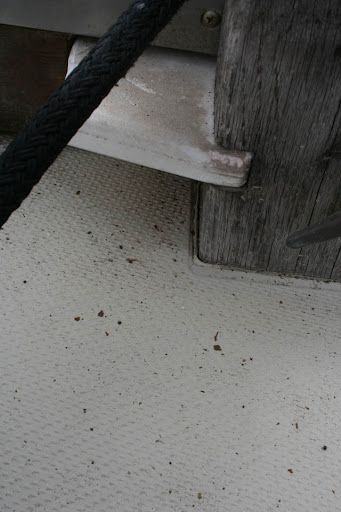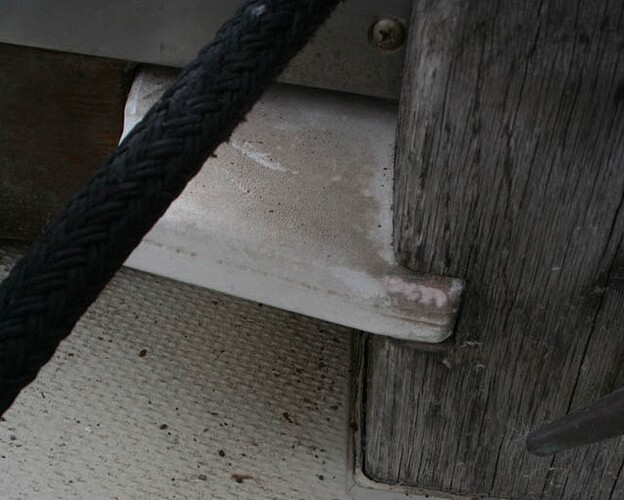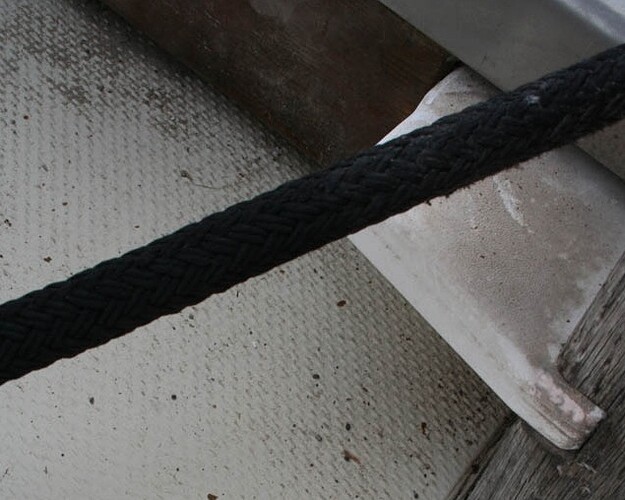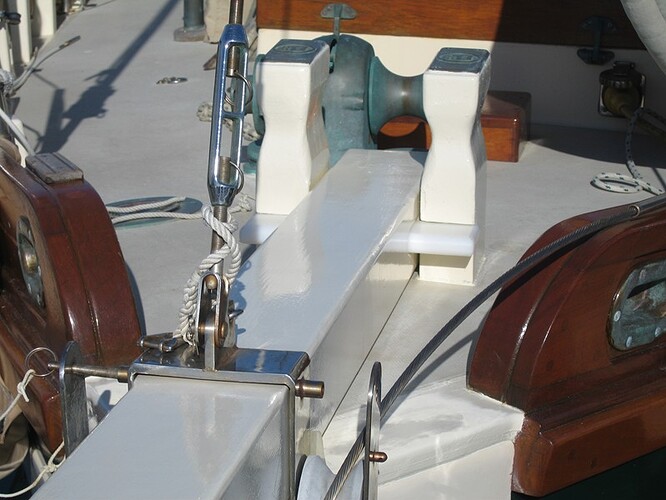I’m considering shortening my bowsprit. The PO of Voyager added two L-brackets to the inboard end of the bowsprit, apparently to stop it from moving laterally along the foredeck. The problem is he had a bad landing somehere and crushed the bowsprit against one of these brackets which led to rot. After looking at pictures of other BCCs I notice that some bowsprits terminate close to the Samson posts. Is there additional lateral support on these that I’m not seeing in the pictures or is the combination of the stays and Samson post sufficient? The bowsprit currently fits snugly between the two posts so I believe they are doing their job.
Do you mean shortening V’s bowsprit so it ends just aft of the Samson posts? Or shortening the bowsprit so you have less sprit forward of the bow?
Shortening #2 is a bad thing. Reduction of foresail area increases weather helm (several owners in the early days of SLM Co asked Sam Morse to shorten their sprits. And then complained of excessive weather helm. Roger Olson restored the design length of the sprit and dealt with the weather helm problem in other, better, ways).
Shortening #1 is okay. Several of the later SLM Co BCCs have trimmed the aft end of the bowsprit, for instance so a Cherub dinghy can fit on the foredeck.
The SLM Co BCC bowsprit was designed so it could be reefed, bringing it aft and inboard. That reduced LOA when calculating berthage prices at a marina or wharf.
The original design follows a traditional fitting with the bowsprit mated to the Samson posts by a mortise and tenon fitting, with a fid (originally of a timber such as oak; Roger Olson changed it to Delrin nylon). Removing the fid means the bowsprit could be easily moved aft.
Installing a roller-furling foil and/or a forward anchor roller makes reefing the bowsprit impossible. Unless you remove the forward anchor roller or have a flexible roller-furler foil.
The gammon iron provides the only other on-deck support. Traditionally, bowsprits floated in the gammon iron, ie they were free to move a little. That’s why it’s called the ‘gammon’ - it’s an old word that refers to the grumbling sound of the bowsprit moving in the gammon iron.
Not all cutters had whisker stays (or bowsprit shrouds as some call them). The BCC does. The bowsprit shrouds provide lateral support to the end of the bowsprit. And that lateral support reduces massively the movement of the end of the bowsprit when the boat is under sail (sit out on the bowsprit under sail in a seaway and you can see and feel the tip moving; I’ve sailed on a trad. gaff-rigged cutter without whisker stays and been amazed by the much greater wanderings of the bowsprit tip).
Some traditional cutters had a gammon iron that did not cover the top of the bowsprit (ie those gammon irons were U-shaped). That meant the sprit could be reefed by lifting its tip. And some argue that U-shaped gammon irons are ‘superior’ to the fully enclosed type on a BCC, with the staysail stay attached to the top of the gammon iron: (1) if the bobstay breaks, the bowsprit just lifts; and (2) steel fittings in the shape of cylinders or 4-sided boxes are not strong under tension and, since rig designers cannot resist installing the staysail stay to the top of an enclosing gammon iron, the result is that enclosing gammon irons are an engineering weak point.
Other than by collision or allision, or failure of the bobstay, bowsprits fail by buckling. The lateral support added by the whisker stays reduces the risk of buckling by increasing the load necessary to buckle the sprit by about 400%.
If V (or any BCC) is experiencing excessive movement of the bowsprit (lots of grumbling at the gammon and chafe of the sprit inside the gammon), I think the better solution (better than adding L-brackets), is good tuning or tension of the whisker stays.
Tom Harrer posted, to this forum, his figures for optimum tensions for all stays and shrouds, including the whisker stays. Tom’s post can found by searching.
Cheers
Bil
Bil,
Wow! Thanks for that! I’m looking at option 2- shortening the sprit aft of the Samson posts. I read in Roger’s book, I think, about shortening the sprit for dinghies.
V’ger’s sprit is held between the samson posts by a ten-inch stainless thru bolt only.removing the bolt frees up the aft end. I’m not sure of the terminology you used in describing the fitting, but it seems more complex. Am I missing something, perhaps the fid, which would what, serve the purpose of snugging up the fit?
Warren: Hi!
I’ve looked, but cannot find a photo that shows what I meant - but it’s a situation where a pic is worth lots of words.
A Google search of bowsprit mortise and tenon yields 450 results, but none on the first page have a neat graphic or photo.
The function of the bowsprit/Samson post joint is to transfer the compressional load that runs from the tip to the heel of the bowsprit to the hull.
Wikipedia has a pleasant page on mortise and tenon joints at Mortise and tenon - Wikipedia
I think a workshop teacher (such as Roger Olson) would call it a loose tenon or feather tenon joint.
The SLM Co bowsprit has a mortise or slot set into it, running athwartships. The tenon is a fid of wood or Delrin that fits snugly into the mortise and extends to port and starboard beyond the bowsprit. The extended parts of the tenon also fit into notches in the forward faces of the Samson posts, so compression forces running along the bowsprit from tip to heel lock the three components (Samson posts, fid, and bowsprit) together.
So the tenon takes the function of V’s through bolt and the hole drilled through V’s bowsprit is the functional equivalent of the mortise.
I prefer the traditional way of doing it: all the compressional force running down V’s bowsprit is transferred to the hull by way of your through bolt. Let’s say your bolt is stainless steel. It is buried in timber. So it may be kept moist and deprived of oxygen for considerable periods of time. Giving rise to some corrosion. Now if your bolt fractures when V is under sail …
A wooden or Delrin nylon fid, should it fail, is going to do so incrementally. Giving some warning before catastrophe.
Cheers
Bil
Is this the pic you are looking for Bil?
Ben,
I get Googles “not on this server” message from that link.
To follow on Bil’s fine explanation…I have found that proper tensioning of the bob, fore, and whisker stays seem to keep my sprit nicely centered between the samson posts and also centered vertically in the gammon iron. Mine comes out every season so I can inspect it and I see little evidence of chafe or wear…a little dimpling on the underside of the aft end from the non-skid…it just barely touches there…could cure it by sanding 0.020" off the bottom for about 6 inches but, for the moment, am too lazy to do the required refinishing.
As an aside, I discovered that once I started using a tension guage (Loos) to tune my rig, all the stays needed to be tighter than my “educated” hand had thought.
I did not search for my rigging tensions as Bil suggested but, if you cannot find them on the Morse site, email me… whitewings3@gmail.com and I’ll try to dig up the file (someplace “safe” in this computer) and send them along.
Tom
My former BCC also had a stainless bolt. It was a spruce sprit for light weight, and was therefore very soft. I experienced 3 failure modes: elongation of the hole through the sprit, bending of the SS bolt, and compression of the spruce at the cranse iron by about one inch. The bolt holes in the posts were fine - they were solid teak. The issues were solved by replacing the bolt, adding a metal tube epoxied into the deformed hole, and adding a 1" hardwood pad expoxied into the end of the sprit as a landing pad for the cranse iron. The pad restored the length of the sprit because the cranse iron had moved aft as it chewed through the soft wood. The original owner had also identified this problem, and had used hardwood dowels set into the sprit, but these were insufficient. The spruce was very light, but perhaps a bit too soft. Never had any issues with movement when the stays were tensioned. I agree that they needed more tension than you would guess. As a former physics teacher, I am interested in the max compression load on the sprit bolt - it should be very high.
Todd
Not even sure this is what you’re looking for now… but, try this link for the pic:
http://picasaweb.google.com/BenEriksen/ElizabethPrePurchase#5191377136154817778
and for the rig tension:
http://beneriksen.com/bcc/rigtension.pdf
I perused Ben’s Elizabeth pre-purchase photo album and found pictures two and three clearly illustrate the SM BCC mortise and tenon. I like it and wish I had it on V’ger.
The condition of the hole through my bowsprit is excellent. No elongation or damage visible. Nothing indicates wear at the gammon iron, so I’ll proceed with my shortening. I like the curl at the inboard end of the bowsprit and will figure out a way of securely grafting it to the new end.
Warren Fraser
in going through old mail I saw your comments on the sprit. We pulled the sprit, refinished and then built a ss box mounted thru deck forward of samson posts. This allowed the sprit to be pulled and provided a secure base for the ABI windlass. So now its back in pristine condition. The tube worked fine.
Have a good new year.
Nate
nathaniel berkowitz, sausalito california
tel: 415 331 3314 fax: 415 331 1854
email:nathanielsf@yahoo.com
— On Tue, 1/6/09, BCC Forums bccforums@samlmorse.com wrote:
From: BCC Forums bccforums@samlmorse.com
Subject: [BCC Forum Post] chocholaty: Re: Bowsprit Support
To: bccforum@samlmorse.com
Date: Tuesday, January 6, 2009, 8:57 AM
Author: chocholaty
Username: chocholaty
Subject: Re: Bowsprit Support
Forum: BCC Forum
Link: http://www.samlmorse.com/forum/read.php?5,7468,7477#msg-7477
My former BCC also had a stainless bolt. It was a spruce sprit for light
weight, and was therefore very soft. I experienced 3 failure modes: elongation
of the hole through the sprit, bending of the SS bolt, and compression of the
spruce at the cranse iron by about one inch. The bolt holes in the posts were
fine - they were solid teak. The issues were solved by replacing the bolt,
adding a metal tube epoxied into the deformed hole, and adding a 1"
hardwood pad expoxied into the end of the sprit as a landing pad for the cranse
iron. The pad restored the length of the sprit because the cranse iron had
moved aft as it chewed through the soft wood. The original owner had also
identified this problem, and had used hardwood dowels set into the sprit, but
these were insufficient. The spruce was very light, but perhaps a bit too soft.
Never had any issues with movement when the stays were tensioned. I agree that
they needed more tension than you would guess. As a former ph!
ysics teacher, I am interested in the max compression load on the sprit bolt -
it should be very high.
Todd
The mortisse and tenon approach to dealing with bowsprit stresses at the samson posts is the way I would like to go in changing my current set up. I have two photos of the arrangement courtesy of Ben’s photo collection of Elizabeth (see links below), but it is difficult to tell the dimensions. From the photo it seems the fid is about an inch thick and about four inches in length, and of course the width spans the distance between the outsides of the samson posts. It also appears the notch in the posts is about an inch deep. Is this estimate about right? Sufficient lengths are my main concern.
Warren: Hi!
I’m not on board at the moment, but my reference notes suggest that the fid is 12" x 4" x 1" and the notch in the Samson posts is 3/4" (ie 0.75").
Cheers
Bil
Hi Bil, Wayne,
Great. Thanks for the measurements.
The .75 inch notch in the posts leaves about an inch and a bit of wood before the thru bolt holes are met. I plan to insert a snug-fitting stainless tube for strength and support and then reinstall the thru bolt.I had thought about filling the holes in the posts and sprit with a hardwood dowel, but think this is more secure.



